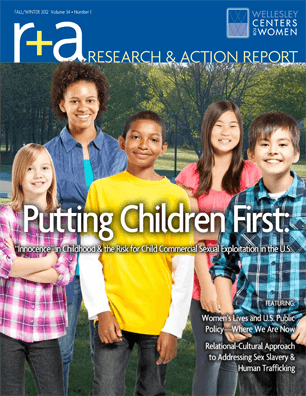Research & Action Report, Fall/Winter 2012
By Kate Price, M.A.
As a society, we often seem to care more about protecting our cultural ideal of childhood innocence than about meeting the actual needs of real-life children—especially commercially sexually exploited children. To fit the ideal of purity, children require high levels of social capital—preferably, they’re white, middle or upper class, and heterosexual. They have limited or no sexual experience, enjoy secure health care, housing, and education, and they live within a supportive nuclear family. In my experience, children living without access to such resources are too often labeled “bad kids” and blamed for “choosing” to exist outside of this ideal.
But children have not always been seen as innocent and separate. In Pricing the Priceless Child: The Changing Social Value of Children (1985), Viviana A. Zelizer contends that changes in the U.S. population and economy influenced the way we view childhood. “[I]n the late nineteenth century a child, not a wife, was likely to become the family’s secondary wage earner. To use children as active participants in the household economy of the working class was not only economically indispensable but also a legitimate social practice.” In the early 1900s, because of a combination of rising childhood deaths due to the increasing numbers of automobiles and streetcars, an influx of immigrant adults needing work, and the advent of formal education to train the next generation of skilled labor, children were relegated to the private spaces of school and home. In their new role, they required protection from working life and the “outside world.”
This model of childhood purity is so culturally engrained that even organizations working to eradicate commercially sexual exploitation of children (CSEC) in the United States may unintentionally further the confusing message. For example, the first words of The Protected Innocence Challenge: Protection for the Nation’s Children, a 2011 report by Shared Hope, an international anti-trafficking non-governmental organization, are “protected innocence.” The final word is “children.” But if we want to help actual children, whose physical and emotional lives are complicated and varied, “children” must come first—literally and figuratively.
I firmly believe that the ideal of “innocence” leaves kids vulnerable to commercial sexual exploitation in three ways:
1. The ideal of innocence is out of reach for many children.
Because they lack adequate care and resources, millions of U.S. children are sexually exploited. The three leading risk factors for CSEC in the United States are a history of child sexual abuse, family violence, and poverty (Williams, 2009; Estes & Weiner, 2001; Silbert & Pines, 1983). Among all industrialized nations, the U.S. has the worst record of child death from abuse and neglect (UNICEF, 2003), and second highest incidence of child poverty (UNICEF, 2012). These statistics are disturbing, as is that fact that most people are not even aware of this data. Estimates across various surveys suggest that one in four girls and one in six boys in this country is sexually abused (Douglas & Finkelhor, 2005), 90 percent of them by either a family member or someone they know and trust (Abel, 2002).
With such a high prevalence of trauma and privation, children need a tremendous amount of support. Our society, however, has chosen to focus on individuals rather than ensuring the wellbeing and growth of children in general or bringing about change at a systemic level. President Nixon vetoed The Comprehensive Child Development Act of 1971 (H.R. 6478), which conceptualized child protection as ensuring the healthy development of all children, out of concern for “family values.” In response, the Child Abuse and Prevention Act that passed in 1974 omitted healthy development entirely and focused on investigating only families already suspected to be in crisis (Young-Bruehl, 2012).
Without a broad prevention program or cultural priority of remedying children’s dire circumstances, children are left to fend for themselves in violent homes and desperate conditions. They often internalize that they are to blame for their desperate situations (Jordan, 1989). The dearth of safe housing and economic opportunity furthers the isolation. Unfortunately, exploiters know that vulnerable children have few choices and manipulate them by promising that they will fill the voids of missing love, protection, and basic needs like food, clothing, and shelter.
2. Children—rather than offending adults—are blamed.
Media scholar Henry Jenkins (1997) refers to childhood innocence as a “modern myth,” stating, “We imagine [children] to be noncombatants who we protect from the harsh realities of the adult world…we are constantly urged to take action to protect our children.” Protection, and therefore a child’s “innocence,” however, is predicated on adult choice the moment a child is abused; he or she enters the “harsh realities of the adult world” and can never return to innocence. The child is not responsible, yet is often punished and now banished from the ideal. The abusing adult is often absolved or hides the crime through parental authority or the cultural assumption that all adults protect children.
In their landmark article, Sexual Child Abuse as an Antecedent to Prostitution (1983), Mimi Silbert and Ayala Pines reported at least 60 percent of the prostituted or exploited women and children they surveyed were sexual abuse survivors. Furthermore, 70 percent of the 200 subjects interviewed stated that the child sexual abuse they endured “definitely” affected their entrance into prostitution. The power and isolation dynamics utilized in abuse leave children with a relational blueprint based on betrayal and control, leaving children vulnerable to being lured into commercial sexual exploitation (Price, 2012). Exploiters often replicate abusers’ grooming tactics of promising love and protection, only to demand sex for survival once the child is trapped.
If we are to end child sexual abuse and CSEC, the question of “Why doesn’t the perpetrator just stop?” needs to preempt “Why doesn’t the victim just leave?” Without focusing on adults’ utilization of deception and dominance to lure children into abusive and exploitive situations, children are at risk for being perceived as active participants in inviting sexual contact. Myths persist that children can be “seductive,” thus culpable and blameworthy in abusive situations (Cromer & Goldsmith, 2010). Innocence is also eroticized in our sex-saturated and “pornified” culture, where children are increasingly sexualized (Renold & Ringrose, 2011). Innocence vanishes the moment a child enters the “adult world” of sex, even if by the force or coercion of exploitation.
3. Stigma leads to shame and isolation.
Sexually exploited children contend with multiple stigmas, which can deepen their sense of shame, putting them at risk for continued exploitation. For instance, since men are the primary purchasers of sex, boys tend to “cloud their participation in CSEC” due to the stigma of homosexuality (Curtis, et al, 2008). Additionally, homeless youth understand the stigma of life on the streets and exchange “survival sex” for food and shelter. Children who suffer from post-traumatic stress disorder from abuse are pathologized as mentally ill and “out of control.”
Surviving these and other stigmas takes tremendous resilience and skill. Yet, sexually exploited children are at risk of being discriminated against because they do not fulfill the role of “innocent victim” when encountering necessary services and supports. According to criminology professor Linda M. Williams (2009), “Instead of a sad-eyed victim [service providers] confront a strong, willful survivor…[who] may be mislabeled ‘offender’ because she does not conform to the stereotype of victim” (p. 60). The very spirit that has kept a child alive now prevents her from receiving help.
Cultural and individual condemnation put the sexually exploited child at risk for further exploitation, because the child feels that “something is wrong with him or her personally and is not worthy of positive relationship on any level” (Miller, 1997). Psychiatrist Jean Baker Miller coined the phrase “condemned isolation” “to capture the experience of isolation and aloneness that leaves one feeling shut out of the human community” (Jordan, 2010). Unfortunately, exploiters are ready, with empty promises of love and safety, to manipulate abandoned children into thinking that exploitation is their only choice.
At a recent Clinton Global Initiative conference, President Obama took a public stand against human trafficking, stating “it is barbaric and it is evil and it has no place in a civilized world” (2012). His speech detailed initiatives and programs to support “innocent victims.” The president’s speech increases the urgency of discontinuing our pursuit of an abstract ideal of “innocence” and instead providing services to human beings who have done nothing wrong. Otherwise, I firmly believe the nation runs the risk of continuing its patterns of exploitation.
To start putting actual children first, we must take responsibility for our international standings in child poverty and deaths due to neglect and abuse. We can acknowledge a change in priorities by ratifying the United Nations Convention on the Rights of the Child, which only the U.S. and Somalia have not endorsed. We must also increase prevention efforts against primary risk factors for CSEC such as child sexual abuse and homelessness. Such policy and program supports are necessary to meet children’s irreducible needs and to provide developmental resources necessary for all children, particularly sexually exploited youth, to be healthy and safe.
References
Abel, G. & Harlow, N. (2002). “The Abel and Harlow Molestation Prevention Study,” http://childmolestationprevention.org/pdfs/study.pdf (Accessed April 18, 2012).
Cromer, L.D. & Goldsmith, R.E. (2010). Child sexual abuse myths: Attitudes, beliefs, and individual differences. Journal of Child Sexual Abuse. 19, 618-647.
Curtis, R., Terry, K., Dank, M., Dombrowski, K., & Khan, B. (2008). The commercial sexual exploitation of children in New York City: Volume one. https://www.ncjrs.gov/pdffiles1/nij/grants/225083.pdf (Accessed August 14, 2012).
Douglas, E.M. & Finkelhor, D. (2005). Child sexual abuse fact sheet. http://www.unh.edu/ccrc/factsheet/pdf/childhoodSexualAbuseFactSheet.pdf (Accessed October 9, 2012).
Estes, R. J. & Weiner, N.A. (2001). The commercial sexual exploitation of children in the U.S., Canada and Mexico. Philadelphia, PA: University of Pennsylvania.
Jenkins, H. (Ed.) (1997). Children’s Cultural Reader. New York: New York University Press.
Jordan, J.V. (1989). Relational development: Therapeutic implications of empathy and shame. Jean Baker Miler Training Institute, Wellesley Centers for Women, Work in Progress, no. 39.
Jordan, J.V. (2010). Relational-cultural therapy. Washington, DC: American Psychological Association.
Miller, J.B. & Stiver, I.P. (1997). The healing connection: How women form relationships in therapy and in life. Boston: Beacon Press.
Obama, B.H. (2012, September 25). Remarks by the President on human trafficking. Retrieved from http://www.clintonglobalinitiative.org/ (Accessed October 10, 2012).
Price, K. (2012). Longing to belong: Relational risks and resilience of U.S. prostituted children. Jean Baker Miler Training Institute, Wellesley Centers for Women, Work in Progress, no. 111.
Renold, E. & Ringrose, J. (2011). Schizoid subjectivities? Re-theorizing teen girls’ sexual cultures in an era of sexualization. Journal of Sociology. 47:4, 389-409.
Silbert, M. & Pines, A. (1983). Child sexual abuse as an antecedent to prostitution. Child Abuse and Neglect 5:4, 407-411.
United Nations Children’s Fund (UNICEF). (2003). Child maltreatment deaths in rich nations. http://www.unicef-irc.org/publications/353/ (Accessed August 20, 2012).
United Nations Children’s Fund (UNICEF). (2012). Measuring child poverty: New league tables of child poverty in the world’s richest countries. http://www.unicef-irc.org/publications/ pdf/rc10_eng.pdf (Accessed August 21, 2012).
Williams, L. M. & Frederick, M.E (2009). Pathways into and out of commercial sexual victimization of children: Understanding and responding to sexually exploited teens. Lowell, MA: University of Massachusetts Lowell.
Young-Bruehl, E. (2012). Childism: Confronting prejudice against children. New Haven and London: Yale University Press.
Zelizer, V. (1985). Pricing the priceless child: The changing social value of children. Princeton: Princeton University Press.


